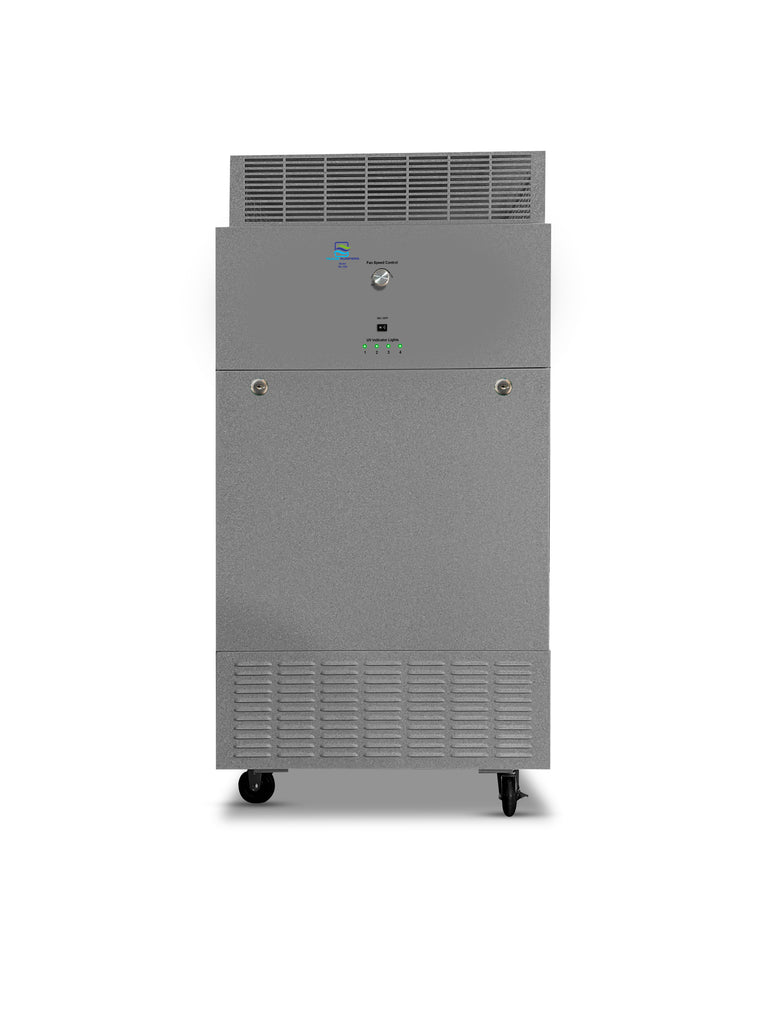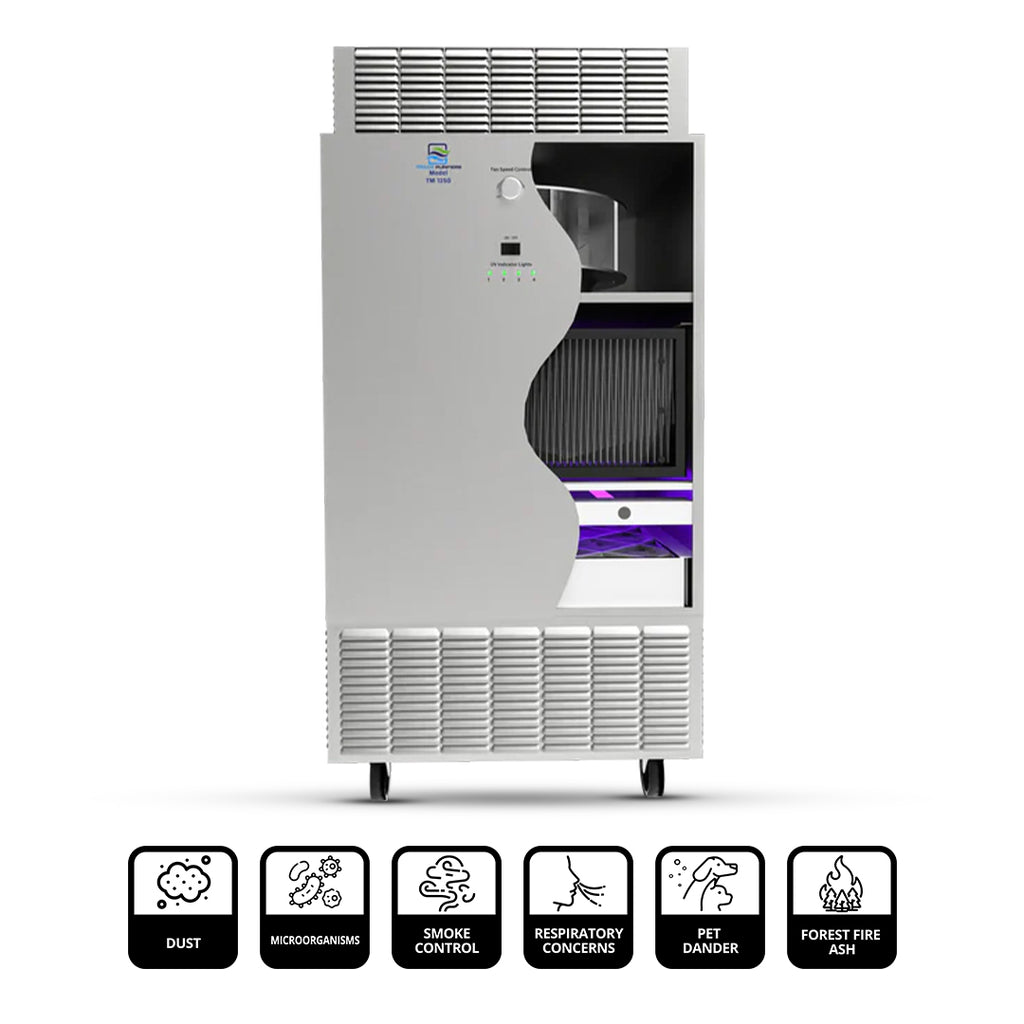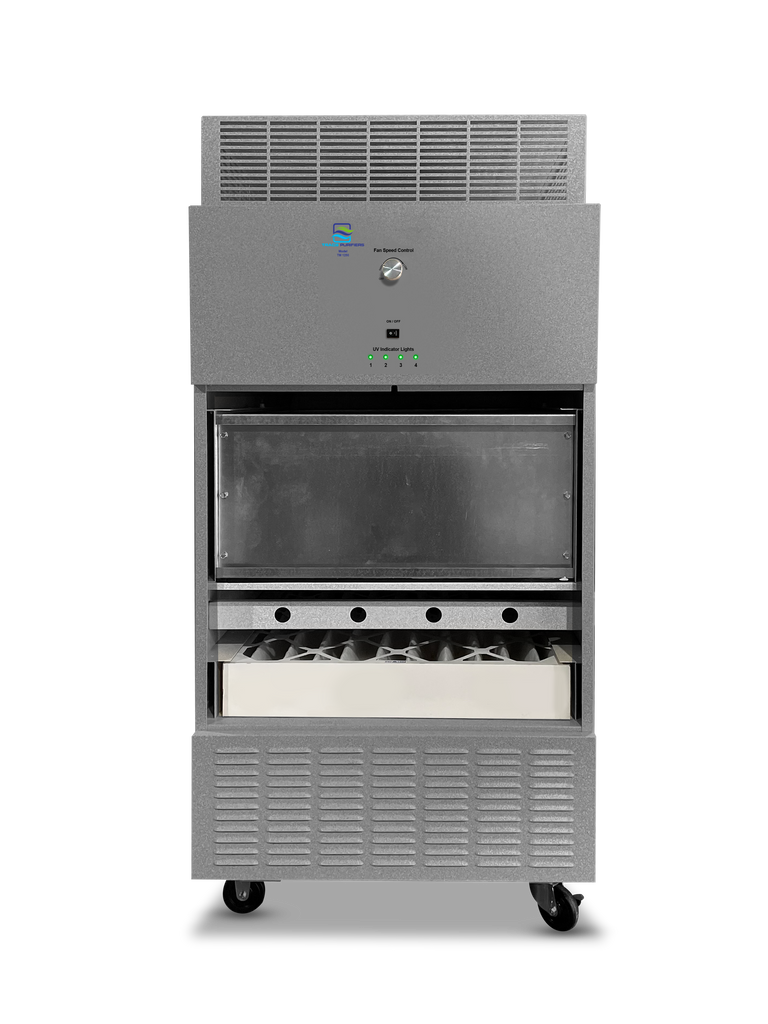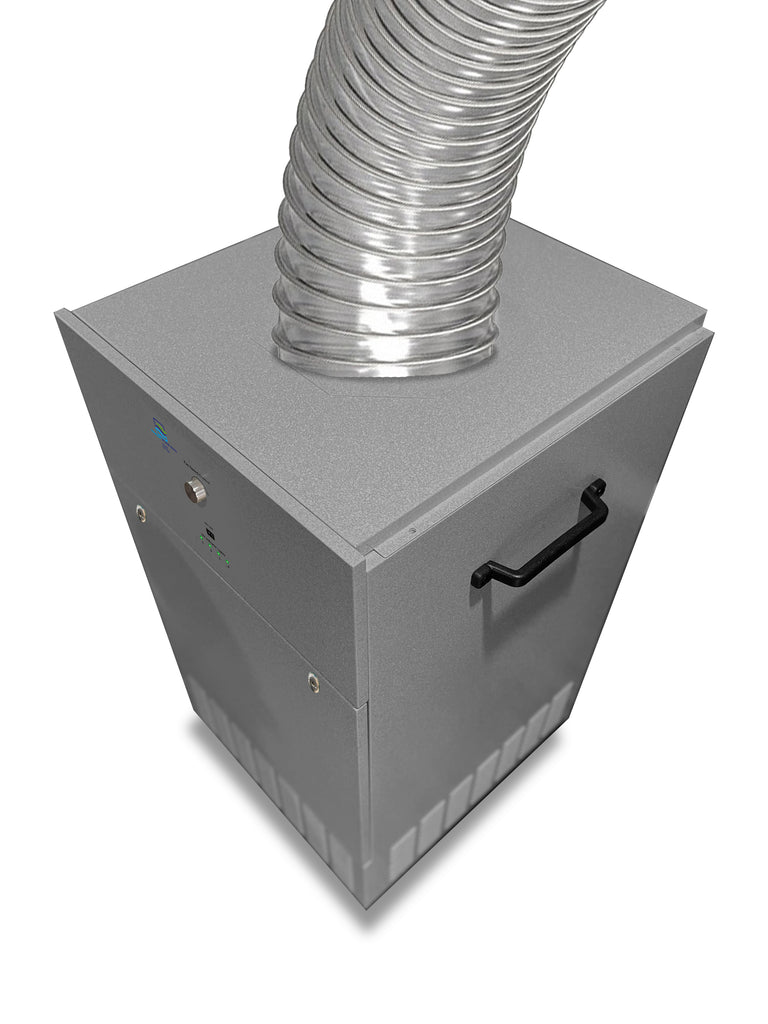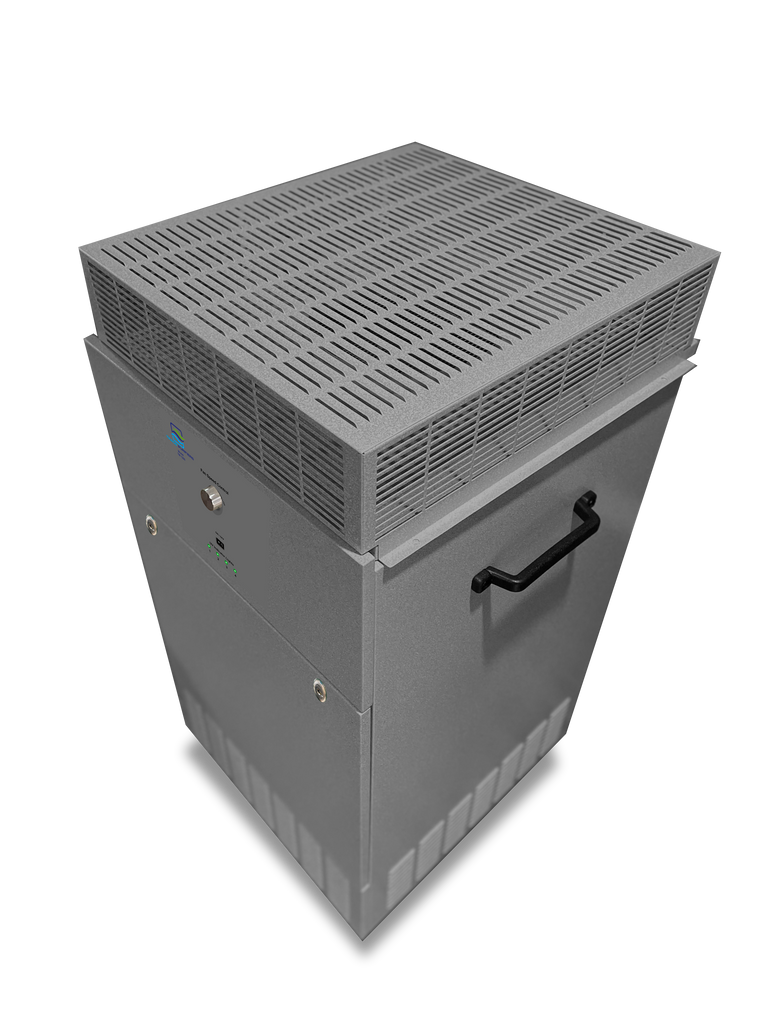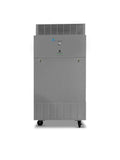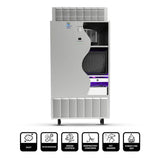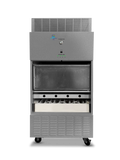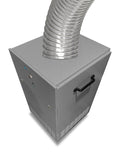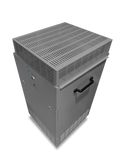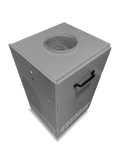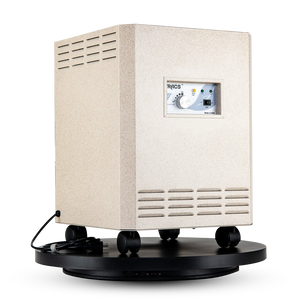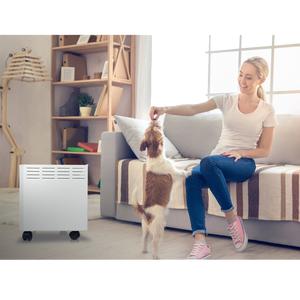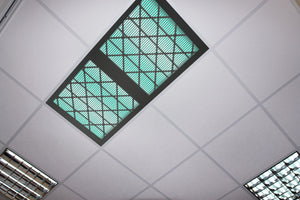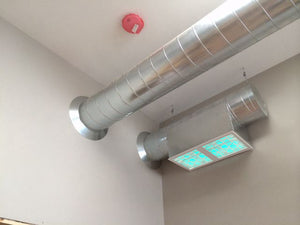TRACS® Model TM-1250 Industrial HEPA Air Purifier with UV and Antimicrobial
- Coverage up to 9,025 sq ft in one hour or 4,500 sq ft every 30 min
- 3 Stage Air Purification- Pre-Filter, UVGI Technology with Hepa Filtration
- Stage 1- Pleated 4" Antimicrobial Prefilter Merv 10
- Stage 2- 92W of UVC Light at 254 nm
- Stage 3-H13 Certified Hepa Filter is 99.99% Efficiency at .3 Microns, last up to 5 Years
- Dual Mode Air Scrubber and Negative Air Machine
- Portable- Rolls into any room and plugs into a standard Electrical outlet
- 5 Year Mechanical Warranty

Highly effective portable air cleaning system used for infection control in medical facilities and laboratories, and for virus, microbial, and particulate protection in commercial and industrial spaces. The TM-1250 recirculates or exhausts through ductwork 1250 cubic feet per minute (high speed) of clean and disinfected air making ideal for use in very large areas.
Technology: Certified HEPA Filtration and Ultraviolet Germicidal Irradiation (UVGI).
Certified HEPA Filtration and Ultraviolet Germicidal Irradiation (UVGI)
High Efficiency Particulate Air Filters (HEPA)
For over eighty years HEPA filters have been the primary mechanism used for removing airborne pathogens, microorganisms, dust, and particulate from the air at very high efficiencies. Standard certified HEPA filters like those used in the TM-1250 are individually scanned and tested to perform at 99.97% efficiency at .3 microns, and it is securely sealed within the cabinet to prevent air bypass around it. If a product contains a “HEPA” filter that is not certified, then in may not perform at HEPA efficiency. The TM-1250 comes standard with a HEPA filter that has a galvanized steel frame to ensure against frame disintegration or warping due to moisture.
Ultraviolet Germicidal Irradiation
UVGI has also been used as a means of destroying airborne bacteria and disease, as airborne microorganisms have been shown to be destroyed when subjected to certain levels of UV radiation. A key aspect of this is the fact that some pathogens may be too small to be trapped by a HEPA filter with 99.97% efficiency, but they are very susceptible to the effects of UV.
Furthermore, the UV lamps in the TM-1250 are installed on the “dirty” (intake) side of the HEPA filter where the dust, bacteria, and microorganisms are collected. Microorganisms like mold, which are difficult for UV to destroy when because of their large size, can actually live and grow on filters (by feeding off of trapped particulate and microorganisms on the HEPA), eventually eating through the filter media and potentially creating pinhole leaks. If this occurs over a long enough period of time, trapped microorganisms can destroy the integrity of the filter, rendering it inefficient and useless or worst a health hazard. However, because the HEPA media is constantly radiated by UV in the TM-1250, trapped molds and other microorganisms that cannot be destroyed when airborne will be effectively deactivated on the HEPA (because the UV is given a long enough residence time to deactivate the microorganism). And by having the UV constantly radiating and “cleaning” the HEPA filter; it creates a safer environment for when the filters need to be changed.
Click here to read current report on how UV-C light inactivated airborne human coronaviruses
| Room Size | Coverage up to 9,025 sq. ft. in one hour or 4,500 sq. ft. every 30 min |
| Dimensions | 44" H x 30" W and 30" D |
| Weight | 235 lbs |
| Air Flow: | Full Variable Speed Control Up to 1,250 cfm on high at 120V/60hz |
| UVC | 92W of UVC Light at 254 nm |
| Electrical | 9A draws 4.5A |
| Technology: | 3 Stage Air Purification: Pre-Filter, Hepa and UVGI Technology. Dual Mode Air Scrubber and Negative Air Machine. Filters Prefilter: 24 x 24 x 4” Antimicrobial Pleat – 30% ASHRAE H13 Certified HEPA Filter: 24 x 24 x 11½” efficiency 99.99% @ .3 microns, lasts up to 5 Years. Metal frame sealed within the TM-1250 cabinet Ultraviolet Germicidal Irradiation – 254 nm Quantity: 4 22” 25W UV lamps Location: Directly before shining on the dirty/inlet side of the HEPA |
| Sound Level: | High Speed: 64 dBA (6' Distance), 61 dBa (12' Distance) Medium Speed 60 dBa (6' Distance), 57 dBa (12' Distance) |
| Construction | 18-gauge powder coated steel removable keyed door access to all replacement parts. Four heavy duty 3” casters, two swivel with brakes and two straight. Durable rubber handle for easy mobility and navigation. Portable - rolls into any room and plugs into a standard Electrical outlet |
| Warranty | 30 Day Money Back Guarantee, 5 Year Mechanical, Lifetime Frame |
Medical Grade HEPA Filter
For over eighty years High Efficiency Particulate Air Filters (HEPA) filters have been the primary mechanism used for removing airborne pathogens, microorganisms, dust, and particulate from the air at very high efficiencies.
Standard certified HEPA filters are 99.99% efficient at .3 microns and higher, meaning they are individually tested to perform at that efficiency. If a product contains a HEPA filter that is not certified, then it may not perform at HEPA efficiency. This is the case with many commercial units that claim to have “true” HEPA filters.
There are many air purifiers on the market today where the media may be HEPA efficiency but it is not adequately gasketed within the filter frame allowing gases and toxic odors to bypass the filter.
“Certified” HEPA filters are individually DOP tested to ensure efficiency. The HEPA filters used in the TRACS Manufacturing ceiling mounted purifiers are all reverse gel seal filters certified to perform at 99.99% efficiency at .3 microns, and the HEPA filter is securely sealed within the cabinet to prevent air bypass around it.
CarbonWeb pre-filter:
TRACS Manufacturing employs activated CarbonWeb cartridges ($29 refill every 6 months) in the pre-filter process to remove toxic gases and odors too small to be stopped by the HEPA filter. Theoretically, we can remove almost all particulate matter from the air stream. We are now faced with “how should the gases and vapors – the chemical pollution – be removed?” HEPA filtration is effective down to the .3 micron range and will remove some particulates smaller than .3 microns. Gases and vapors are .01 microns and smaller.
Benzene and naphthalene, two compounds that are strongly adsorbed by carbon, are approximately .0006 and .0007 microns respectively. One micron equals 1/25,400 of an inch. Very simply, particulate filters do not, and can not, remove material that is this small and is a gas. If particulate means cannot be used to remove gases, then how can they be removed?
For HVAC applications, where the concentrations are very low and the contaminant loading varies constantly, adsorption has proven to be the most effective and the most economical process.
Adsorption with activated carbon is also the process of choice for applications such as gas masks, space capsules, nuclear submarines and radioactive iodine removal (nuclear plants). Are there other processes to remove gases from an air stream? Certainly, there are other processes. When higher concentrations are present, incineration, chemisorption and solvent recovery [an adsorptive process] all have their places.
- All Children’s Hospital
- Bronx School District
- Savage Arms Inc.
- Stonybrook College
- John’s Hopkins Medical
- Mayo Clinic
- Foxwoods Casino
- Mohegan Sun Casino
- Hartford Hospital
- St. Francis Hospital
- Cleveland Clinic
- NASA Offices - Cleveland
- NASA Offices - Cape Canaveral
- NASA Offices - Houston
- General Services Administration
- Metropolitan Museum of Art - NY
- Michigan State PD
- Endita Medical Center
- El Paso County Health Dept.
- Valverde Correctional Facility
- Missouri Department of Health - Every hospital in Missouri has a medical unit
- Hawaii Dept. of Corporate Council
- Kapiolani Medical Center
- Dept. Rehab Services - OK Grainger
- Church of Scientology
- Crescent City Police Department
- Kyle Police Department
- City of Kansas City
- Green County Sheriffs Office
- Surfside Beach Police Department
- Big River Ambulance District
- Dept. of State Health Services - TX
- Colleyville Police Department
- North Haven Police Department
- City of Deltona
- City of Seguin
- Immunovative Clinical Research
- David Pena Best Research Solutions
- US EPA - Washington DC
- Humane Association of Warren County
- US Air Force
- City of Bunnell Police Department
- Ritz Carlton Hotels
- Good Samaritan Clinic
- Nat. Institute of Health -
- Bethesda Kyle Police Department
- Ronald McDonald House
- Life Vessel Santa Barbara
- Shiepis Clinic
- United States Army
- Dow Chemical
- Northern California Power Agency
- San Leandro Hospital
- Columbia University
- Palm Beach Housing Authority
- NW Community Mental Health
Recirculation Option:
As a recirculation unit, the TM-1250 is used to turn virtually any patient room into an Isolation Room, helping to protect health care workers from exposure to contaminated air. The most important aspect of any air cleaner is the air flow pattern created, as only air that passes through the unit can be effectively cleaned and disinfected. With the TM-1250-P, an excellent air flow pattern is created to ensure maximum effectiveness and contaminant removal. Air is drawn into the lower end of the unit on all four sides and from the bottom to create maximum air pull, and exhausted from the upper end of the cabinet on all four sides and from the top at a 45 degree angle. This ensures excellent air mixing occurs throughout all corners of the room, preventing dead air spots from occurring on each side of the unit (as can happen when air is only exhausted in one direction). Furthermore, the height of the TM-1250R-P allows for clear separation of air intake and exhaust, guarding against “short circuiting” of clean air that can occur in smaller units.
Negative/Positive Pressure Options:
The units can be installed to create positive or negative pressure, depending on the location of the unit and exhaust air. To create a negative pressure room, (such as for a TB Isolation Room or a bronchoscopy/sputum room), the unit should be installed in the room where negative pressure is desired, and the exhaust air should be sent out of the room. To create negative pressure in a TB isolation room as per CDC guidelines, exhaust flows of at least 10% greater than supply air (but no less than 50 cfm) must occur, and all existing return air should be blocked off. For instance, a room having 300 cfm supply air must have at least 350 cfm exhaust (because you need at least 50 cfm more).
To create a positive pressure room, (such as for an operating room or immune-deficiency room), the unit should be installed outside of the room where positive pressure is desired, and the exhaust air should be sent back into the room.
Combination UVGI/HEPA
Having both technologies provide double assurance that the air is completely clean and safe. Moreover, HEPA-only units are less efficient at removing viruses and can have problems with interior bacteria/microbial growth, while UV-only units provide no particle reduction at all.
Low Replacement Costs
UVGI not only enhances the effectiveness of the unit, but it also reduces the replacement costs, thereby increasing the overall efficiency. The most expensive replacement cost of any similar air cleaning device is the HEPA filter. In HEPA-only systems, mold and microbial growth can occur on the HEPA filter, so HEPA filters should be replaced at least once per year (even if the HEPA filter is not clogged). If they are not replaced, the microorganisms can actually eat through the HEPA media (this is known as bacteria grow-through), and ruin the integrity of the filter (and the overall air cleaning system). However, with the TM-1250, the entire HEPA filter is constantly bathed in UV light, so mold and microbial growth cannot occur. Given this and a prefilter that will take out larger dust particles, the HEPA filters in our systems can last up to three years (depending on particulate load), thereby lowering unit maintenance costs. Lastly, all replacement filters are standard sizes, keeping costs at a minimum and even allowing for local supplying of them if necessary.
HEPA Locking Mechanism
The galvanized HEPA filter in the TM-1250 is mechanically sealed into place to prevent air bypass around the HEPA filter. Pressure applied by thumb screws compresses the HEPA’s gasketing against the HEPA shelf to create a tight seal and ensure the unit’s efficiency.
Mobile Option
The TM-1250 is easily transported throughout the facility on heavy duty 3” locking casters. A convenient handle is located on the side of the unit to allow for easy navigation and movement through the facility.
Ease of Conversion to Negative Pressure/Recirculation System
The TM-1250 comes standard as a negative pressure unit with a 12” collar on the top for duct connection. However, if in-room air recirculation is desired, the unit can quickly and easily be converted into a recirculation system by simply installing the recirculation top four screws.
Location of blower
As recommended by ASHRAE and hospital guidelines the blower in the TM-1250 is located after the filtration technologies (specifically the HEPA filter), thereby preventing contamination of the blower components.
Compliance with CDC and OSHA Guidelines
The technology and type of function provided by the TM-1250 is endorsed and recommended by the Center for Disease Control for control of Tuberculosis and other infectious disease. As such, when using the TM-1250 correctly, facilities comply with CDC and OSHA standards for infection control.
Safety Interlock
A safety interlock mechanism is in place that will automatically shut down all power to the unit when the access door is opened. This prevents direct exposure to UV radiation and to any powered electrical components.
Full Variable Speed Control
Allows for use in a wide range of rooms both small and large.

